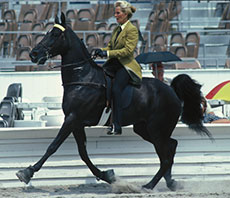

Photo courtesy of USDA APHIS
Tennessee Walking Horses are known for their graceful, flowing motions and long strides. Their distinctive gaits often are exaggerated by the use of stacked shoes, now banned by the U.S. Department of Agriculture.
The U.S. Department of Agriculture finalized last week a new rule to strengthen regulations against soring, an abusive horse-training technique that's persisted despite being illegal for nearly half a century.
The rule, signed Jan. 11 by David Howard, acting deputy under secretary for USDA Marketing and Regulatory Programs, is intended to fortify the Horse Protection Act of 1970. The act outlawed the use of chemicals and other means to inflict pain on the legs of show horses to achieve an exaggerated high-stepping gait. The practice is known as soring.
Changes to the regulations, most of which take effect on Jan. 1, 2018, are intended to steel existing HPA provisions against conflicts of interest, eliminating the inspection by industry insiders of horse breeds impacted by soring. Instead, inspections will be conducted by independent third parties. So-called "action devices," including the high-stacked shoes that are used to enhance the dramatic gait of the Tennessee Walking Horse and other breeds, also are prohibited.
Proponents of the changes contend that many in the show industry have thwarted the Horse Protection Act for decades, using cronyism and counter legislation to deter the law's effectiveness and implementation. The act was watered down in 1976 with the passage of an amendment to create a Designated Qualified Person (DQP) program, which allowed people connected with the horse industry — farriers, trainers or veterinarians — to inspect horses at shows and sales.
Oversight currently operates this way: USDA authorizes Horse Industry Organizations (HIOs) with vetting and certifying DQPs to check horses for signs of soring, such as scars and soreness on the forelegs, before and after competitions. Hired by the very entities they're asked to police, DQPs often ignore violations, welfare advocates say, and trainers have become better at hiding signs of abuse. The downside of self-policing is apparent in the numbers of violations reported to USDA, critics note. When horses are inspected by DQPs alone, violation rates are said to hover around 2 percent, while they are more than double that rate when government veterinarians are present.
Implementation of USDA's final rule upends that system and reflects recommendations of the Office of the Inspector General, which found during a 2010 audit that existing industry-led inspections were inadequate for ensuring HPA compliance.
The new rules are the latest in a series of attempts to enhance the HPA and the ability of the agency's Animal and Plant Health Inspection Service to enforce it. Congress considered two bills to amend the HPA in 2013, but both died in committee as lawmakers wrangled over their competing provisions. A version of one of those bills, the PAST Act, was introduced in 2015 but also failed.
Because only Congress has the authority to rewrite the HPA, USDA aimed to alter its regulations. Tanya Espinosa, press affairs specialist for USDA APHIS, said the agency's goal is to "achieve the congressional purpose of the HPA — ending the cruel and inhumane practice of soring horses and unfair competition."
While veterinarians and other welfare advocates applaud the changes, many in the industry are opposed. Among them is Sen. Lamar Alexander, a Republican from Tennessee, where an estimated 90,000 walking horses reportedly are registered.
In a statement, Alexander noted that the Tennessee Walking Horse industry supports more than 20,000 jobs nationwide and pumps $3.2 billion into the nation’s economy. He called the rule "overreaching."
"I am in favor of wiping out the contemptible and illegal practice of horse soring, not wiping out the century old tradition of showing Tennessee Walking Horses as this rule could do," he said.
USDA's new regulations state that:
• APHIS will license, train and oversee independent, third-party inspectors known as Horse Protection Inspectors (HPIs), and establish their licensing eligibility requirements to reduce conflicts of interest. HPIs will replace the DQIs. To allow sufficient time to retain and train HPIs, the inspection licenses of DQIs will remain valid until Jan. 1, 2018, when the changeover will take place.
• Managers of horse shows, exhibitions, sales and auctions that elect to use inspection services must appoint and retain a HPI by Jan. 1, 2018.
• Regulatory provisions applicable to Horse Industry Organizations and associations are no longer effective.
• Thirty days after the final rule's Jan. 13 publication, all action devices apart from certain boots are prohibited on any Tennessee Walking Horse or racking horse at any horse show, exhibition, sale or auction. All pads and wedges are prohibited after Jan. 1, 2018, unless they're prescribed for treatment by a veterinarian. The delayed implementation allows time to gradually reduce the size of pads to minimize any potential physiological stress to the horses and prepare them to compete in other classes.
• Management of larger HPA-covered events that involve Tennessee Walking Horses or racking horses must, among other things, provide HPIs with the access, space and facilities needed to conduct inspections and have a farrier available to assist them. If the event includes 150 or fewer entrants, management must have a farrier on call to assist inspectors.
Update: The new rule is in limbo pending a review by the Trump administration. While the USDA posted the rule on Jan. 13 as final, it had not been published in the Federal Register before the White House transition on Jan. 20. Therefore, it is subject to a freeze that was placed on all pending regulations.